#wapiti bull
Text
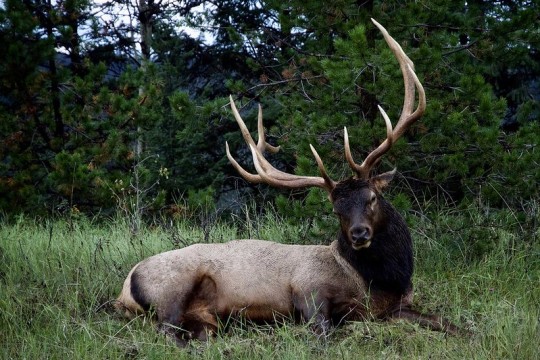
Wapiti
Bull Elk, Jasper National Park, Alberta, Canada.
By Paddle Man
#paddle man#photographer#flickr#wapiti#bull elk#elk#animal#mammal#wildlife#jasper national park#alberta#canada#nature
32 notes
·
View notes
Text

size difference
1 note
·
View note
Text

A wapiti bull (Cervus canadensis) grazes in Grand Canyon National Park, Arizona, USA
by jaffles
#wapiti#elk#american elk#deer#cervus canadensis#cervus#cervidae#artiodactyla#mammalia#chordata#wildlife: arizona#wildlife: usa
878 notes
·
View notes
Text
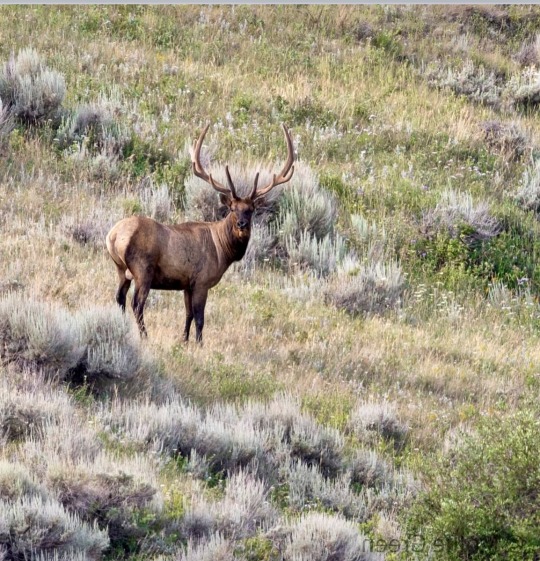
Bull Elk (wapiti) on Buffalo Creek
8/06/2022
180 notes
·
View notes
Note
its an elk (wapiti-not a moose) with growing antlers and velvet!! seems to be in the middle stage of being a spike and bull-so basically a young adult (sorry if this sounds so weird idk how to answer tags in reblogs XD)
Aaaa thanks!!!! I'm trying to figure out my deer theriotype, that's why I asked hehe
3 notes
·
View notes
Text
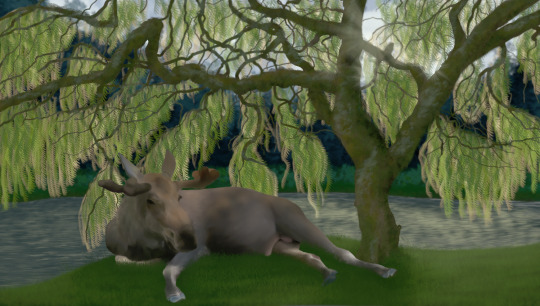
Deercember Day Twenty-Three: Moose | Weeping Willow
The moose (Alces alces), also known as the Eurasian elk outside of North America, is widespread globally, with populations in North America, Europe, Asia, and possibly New Zealand. The word "moose" first entered the English language by 1606 and is borrowed from the Algonquian languages (compare the Narragansett moos and Eastern Abenaki mos). The moose is the tallest, and the second-largest, land animal in North America, only falling short of the American bison in terms of mass. It is the world's tallest, largest, and heaviest extant species of deer: on average, an adult moose stands 1.4 – 2.1 m (4 ft 7 in – 6 ft 11 in) high at the shoulder, which is more than 30 centimetres (1 ft) higher than the next-largest deer on average, the wapiti, or North American elk. Males (or "bulls") normally weigh from 380 to 700 kg (838 to 1,543 lb) and females (or "cows") typically weigh 200 to 490 kg (441 to 1,080 lb). Moose are resourceful and adaptable animals, adjusting to environmental changes and giving-rise to increased sightings of "urban moose" in some areas. Numerous sightings of moose casually walking down city streets have been documented, as well as sightings of young bulls sparring in suburban driveways. Females with young calves have been documented aggressively chasing vehicles to 'defend' their young, as well as relaxing in public parks or browsing plants in home gardens. More information here.
References: Moose, Willow and Background.
#I spent vastly too long working on this one but I'm tickled with it so I accept#less technically impressive than some others but he's just so cute#I only redid the willow leaves once!#this is the cosiest animal alive#Deercember#realHum#Art#Drawing#deer#deer art#moose#Eurasian elk#Alces alces
2 notes
·
View notes
Text
WOLFQUEST: AE THREAD
SCORCH-Burn Creek Pack 3M
Later documented; Fossil Forest Pack 1M


Talon and Nightingale's second surviving son, the runt of the first litter, dubbed Scorch by researchers, was the first of the Burn Creek Adolescents to venture away from home and establish himself as a lone dispersal wolf. Having outgrown his previously tiny stature, now Scorch seeks to carve out a place in Yellowstone for himself.
Scorch is an over confident wolf, possibly a leftover trait from having been babied so much as a pup. This showed primarily in his first attempts at hunting elk, which were nearly disastrous.
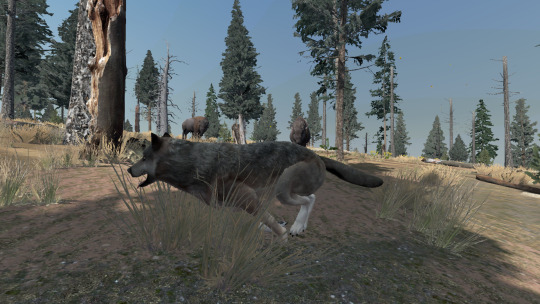
Though Scorch was able to bring down a particularly sickly calf, this left him with a lame leg and busted jaw for much of early fall, rendering him having a more than difficult time hunting for himself and leaving him relying on scavenging.

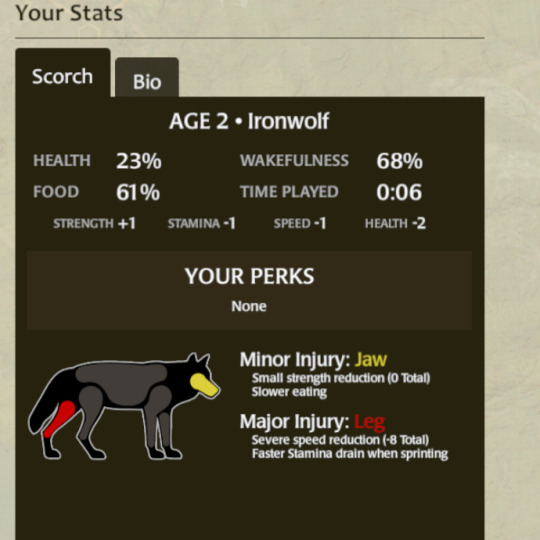

It wasn't long before Scorch began to do what Dispersal wolves do best, invade other pack territories to nab some of their members around his age.
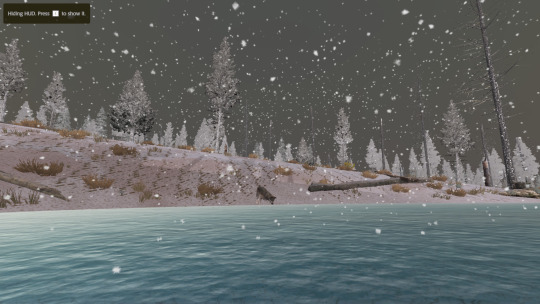
His main point of interest seemed to be the Wapiti Pack to the South of Amethyst.
Often, he found himself entangled with the oldest male wolf, though Scorch was large enough to handle the older wolf on his own through their several harrowing encounters.
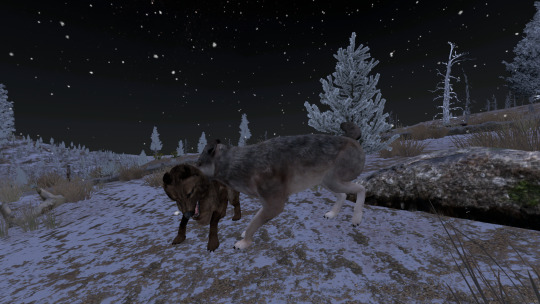
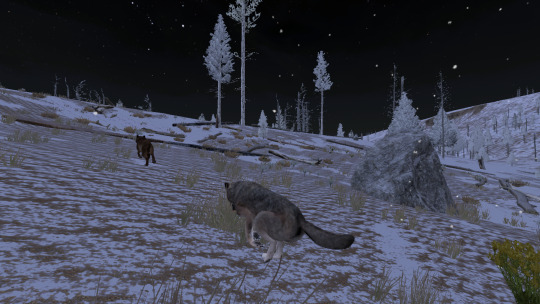
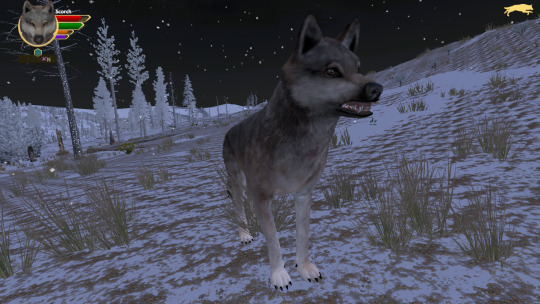
Though Scorch would have little luck with the Wapiti females. Or any females that he ran into in Pack Territories for that matter.
All the while, a small fellow dispersal from the Biscuit Pack, just a little over a year his elder, kept tailing him, identified by researchers as Biscuit 113F. Often seen in the distance tailing Scorch, she seemed to not grab his interest.

Scorch would continue to scour the Eastern Side of Amethyst Mountain. North to the Lamar Pack, West to the Rescue Creek Pack, and then South once again back into Wapiti territory. All with no luck luring some of their bachelorettes.
His leg injury proved particularly heinous, and many researchers feared he would starve to death were it not for his incredible luck while scavenging.
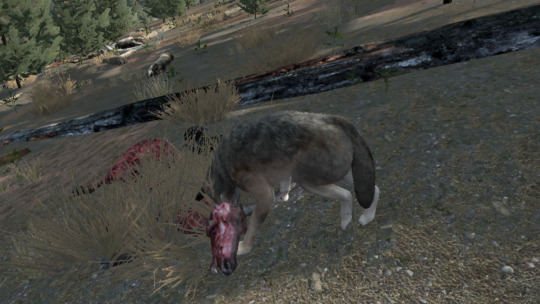
And his skill as a Hare Hunter.

Never the less, the days and weeks trudged forward and despite expectations, just as when he was a pup expected to succumb to illness, Scorch refused to lay down and die.

His best stroke of luck came about when he came upon a bull bison carcass, managing to chase off the coyotes that scrapped with him for the rest of the large kill, sleeping on top of the gore once he had gorged himself on it after days with no food.
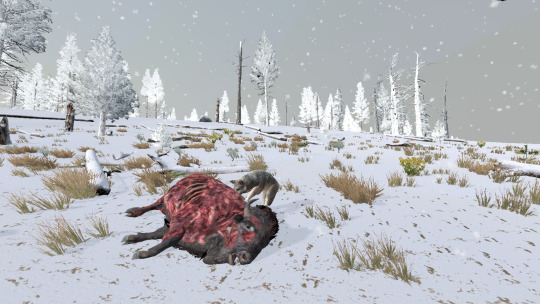
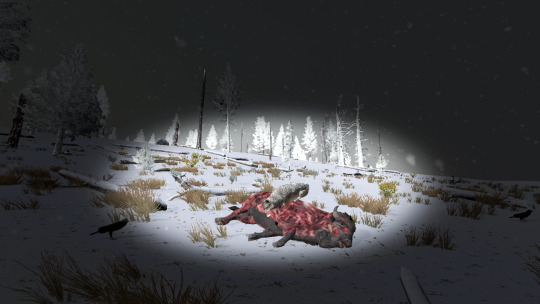
When he woke that evening, the small dispersal from the Biscuit pack had found him once again. And maybe it had been the weeks of no luck with any of the pack females, or maybe it was her tenacity and determination, but she managed to win him over.


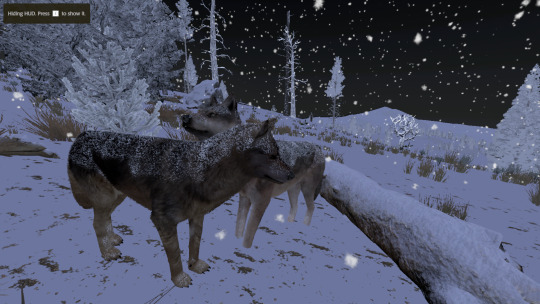
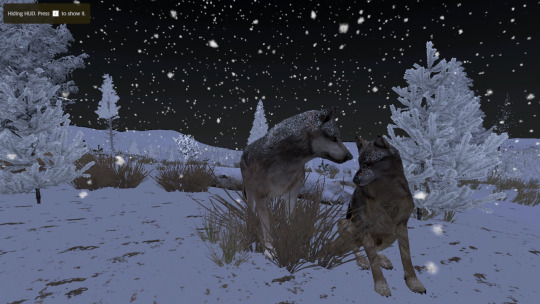
It was an incredibly short courtship period. She had more winning over to do than he did, and by then he was already more than impressed that she hadn't left him in the dirt. After further observation and locating some records regarding the Biscuit pack, it is theorized by researchers that she was likely also a runt that managed to survive till adulthood. She would be referred to as 'Aurora' from this point forward.

The brief snowfall waned as the two settled themselves smack in the middle of the eastern side of Amethyst Mountain.
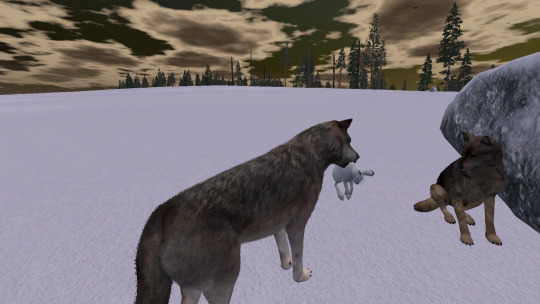
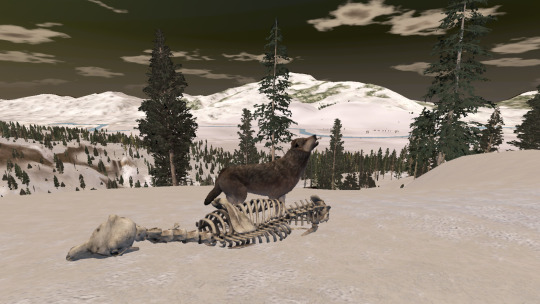
#wolfquest#video games#gray plays#gray plays wolfquest#gray plays wolfquest ae#character tag: scorch#character tag: aurora
5 notes
·
View notes
Text
Deer of up North
There's lots of deer and I can't keep them straight, so here's a list of all deer species found in the subtemperate regions of the Northern hemisphere: Canada, northern Europe, Siberia. This list does not cover the many other deer species.
General deer facts
Deer are ruminants: even-toed ungulates that chew their cud. Yes, that means all true deer are kosher. They're all herbivorous (which means they'll eat meat only if they don't have to work hard for it). True deer are the family Cervidae, but some other species are called "deer" based on looks.
In almost all species, males grow and shed antlers once a year, and females lack antlers. Males also tend to be much larger than females.
Depending on species and region, a male deer is called a stag, buck, or bull; a female deer a doe, hind, or cow; a young deer a fawn or a calf. In French, the male is called the generic term for deer, un cerf; the female is une biche and the young un faon.
Deer are smaller than you expect, except moose, which are bigger. Most deer species have shoulder heights between 50 cm and 1 m. Deer on this list are on the larger side because they live in cold areas.
Most deer are polygynous, with one mating season (rut) per year. Males fight with their antlers over groups of females. Pregnancy is long, and most species have one fawn at a time.
There are 12 species of deer in the area I'm talking about. 11 are true deer, 1 is an impostor amogus.
Red deer (Cervus elaphus)
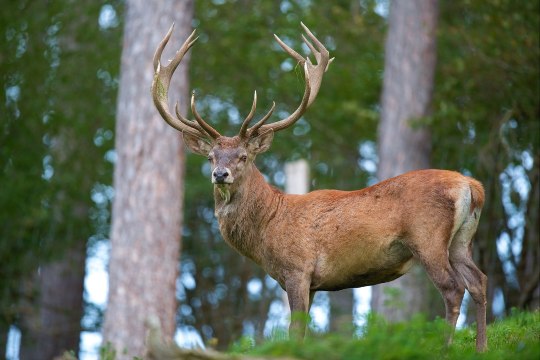
Stag red deer in a forest near Rochefort, Belgium. Photo by Luc Viatour, 2011.
Name in English: Red deer.
Name in French: Usually just cerf since it's the default European deer. Cerf élaphe if you're pedantic.
Lives in: Europe and Western Asia. Introduced in Australia, New Zealand, and South America.
Shoulder height: 1–1.3 m. Red deer are very big as deer go.
This deer is common in Europe, and often hunted and portrayed in art. It's rather social and forms herds. It lives in woods, and migrates to higher altitudes in summer.
Wapiti (Cervus canadensis)

Bull wapiti in Jasper National Park, Alberta, Canada. Photo by Membeth, 2019.
Name in English: In Europe, wapiti. In North America, elk. Ambiguity warning: in Europe, elk usually means moose (Alces alces).
Name in French: Exactly the same problem, with the cognate terms. In Europe, wapiti. In North America, élan. Ambiguity warning: in Europe, élan usually means moose (Alces alces).
Lives in: North America and East Asia. Introduced to South America and New Zealand.
Shoulder height: 0.8–1.5 m. They're even bigger than red deer on average.
The wapiti is closely related to the red deer, and occupies a similar niche. Their native ranges don't overlap, but they often hybridise where both species are introduced.
Sika deer (Cervus nippon)
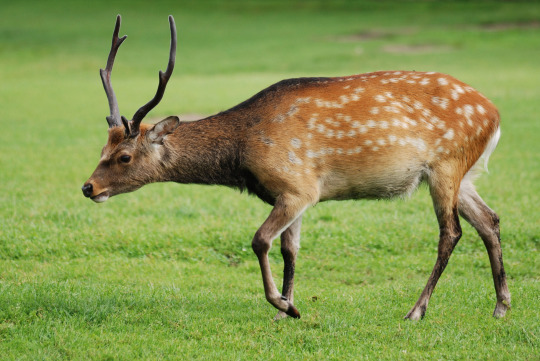
Stag sika deer in Poland. Photo by Lilly M, 2007.
Name in English: Northern spotted deer, Japanese deer, sika deer.
Name in French: Cerf sika.
Lives in: East Asia, mainly Japan. Introduced to a whole bunch of countries, including Canada, the United States, Russia, and many European countries.
Shoulder height: 0.5–1.1 m depending on sex and subspecies.
The sika deer remains spotted as an adult, whereas in most species, only fawns have spots. Its distribution is weird af: its native range is a big chunk of East Asia, but it's died out in most of it, except in Japan where it's breeding like crazy, and it has introduced breeding populations in random places. It's closely related to the red deer and they sometimes hybridise.
Fallow deer (Dama dama)

Buck fallow deer in a field in the German state of Schleswig-Holstein. Photo by Johann-Nikolaus Andreae, 2008.
Name in English: Usually simply fallow deer. European or common fallow deer to clarify.
Name in French: Daim. To clarify, daim européen.
Lives in: Native to Turkey. Introduced in most of Europe, North and South America, parts of Africa, Oceania.
Shoulder height: About 85 cm.
Another deer that stays spotted as an adult, though there are many colour variants. It too has a weird distribution. Its antlers have a broad, flat shape.
Reeves's muntjac (Muntiacus reevesi)
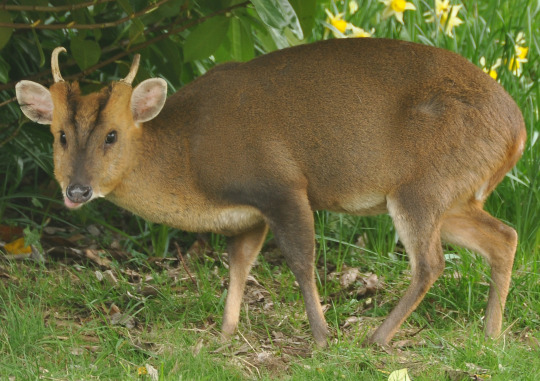
Buck Reeves's muntjac in a garden in England. Photo by Nilfanion, 2010.
Name in English: Reeves's muntjac, Chinese muntjac, barking deer. Sometimes spelt muntjak.
Name in French: Lots of different names, none of which are commonly used: muntjac de Reeves, muntjac de Chine, cerf aboyeur, cerf muntjac.
Lives in: Native to Taiwan and southeastern China. Introduced in Europe and Japan.
Shoulder height: About 50 cm.
There are many species of muntjacs, but only one has established breeding populations far enough north to make this list. All of them are small for deer and breed year-round instead of seasonally.
Bucks of all muntjac species have both tusks and antlers. The tusks are the main weapon; the antlers are short and mostly used to knock opponents out of balance and into tusk range. Fun fact: the ancestor of deer had tusks and no antlers, but true deer lost their tusks, and some lineages re-evolved them.
Roe deer (Capreolus capreolus)

Roebuck in Vaxholm, Sweden. Photo by Bengt Nyman, 2023.
Name in English: Roe or roe deer. If you're pedantic, European or western roe deer.
Name in French: Chevreuil. If you're pedantic, chevreuil d'Europe. Ambiguity warning: in Canada, chevreuil can mean the whitetail (Odocoileus virginianus).
Lives in: Europe and parts of western Asia.
Shoulder height: About 65 cm.
Roe deer use forests for cover, but often venture into open areas to graze. Outside mating season, they're solitary and territorial. The doe usually has two fawns rather than one, typically a male and a female.
Siberian roe deer (Capreolus pygargus)

Siberian roebuck at the Daursky Nature Reserve in Zabaykalsky Krai, Russia. Photo by Andrey Giljov, 2016.
Name in English: Siberian, eastern, or Asian roe deer.
Name in French: Chevreuil de Sibérie or chevreuil d'Asie.
Lives in: Take a wild guess: Asia, mainly Siberia.
Shoulder height: About 85 cm.
This species is extremely similar to the closely related western roe deer, except that it's taller and thinner, and its antlers are longer. It's named pygargus after its white rump, which the western roe deer also has, so idk man.
White-tailed deer (Odocoileus virginianus)

Buck whitetail in the United States. Photo by Scott Bauer, 2001.
Name in English: Whitetail, white-tailed deer, Virginia deer (it's not particularly Virginian but ok).
Name in French: If you're being pedantic, cerf de Virginie. In Québec, sometimes chevreuil. Ambiguity warning: in Europe, chevreuil means the roe deer (Capreolus sp.).
Lives in: North, Central, and parts of South America.
Shoulder height: Varies hugely, 0.5–1.2 m depending on subspecies.
The default North American deer. Bambi from Bambi (1942) is a whitetail.
It mostly lives at the edge of forests, often near humans. When spooked, it raises its tail, showing the white underside. This alerts other deer to danger. Litter size varies, with one, two, or three fawns.
Mule deer (Odocoileus hemionus)

Buck mule deer in the US state of Oregon. Photo from the Oregon Department of Fish & Wildlife, 2010.
Name in English: Mule deer. Some subspecies are called black-tailed deer.
Name in French: Not present in any French-speaking areas, but cerf hémione or cerf mulet.
Lives in: Western half of North America.
Shoulder height: 0.8–1 m
Named for its huge-ass ears. Litter size is usually two fawns, sometimes one. It's not very social and usually solitary, but can also form small groups. Infuriating fact: there's a subspecies called the Sitka deer after the city of Sitka (Alaska, USA), completely unrelated to the sika deer.
Reindeer (Rangifer tarandus)
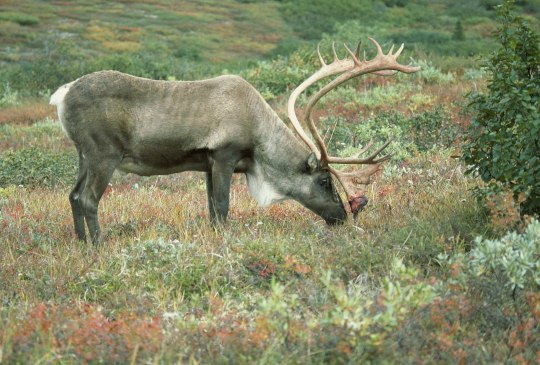
Wild bull reindeer in Alaska. Note the remains of shedding velvet on the tip of one antler. (Or don't note it, I'm not a cop.) Photo by Dave Menke, U.S. Fish and Wildlife Service, 1995.
Name in English: Reindeer or caribou. Reindeer is more common in Europe, caribou in North America. Some people use reindeer for domestic subspecies and caribou for wild ones.
Name in French: Renne or caribou, with roughly the same usage patterns.
Lives in: Canada, Siberia, extreme north of Europe.
Shoulder height: Varies hugely by subspecies, 0.8–1.5 m.
Reindeer live in large herds. Different subspecies migrate very long distances, short distances from mountain in summer to lowlands in winter, or not at all.
They have the biggest antlers of all deer, relative to body size. Females also have antlers, which they use to compete over food during pregnancy. They lose their antlers after calving, later in the year than males.
All societies around the north pole heavily herd or hunt reindeer, and often portray them in art and culture.
Moose (Alces alces)
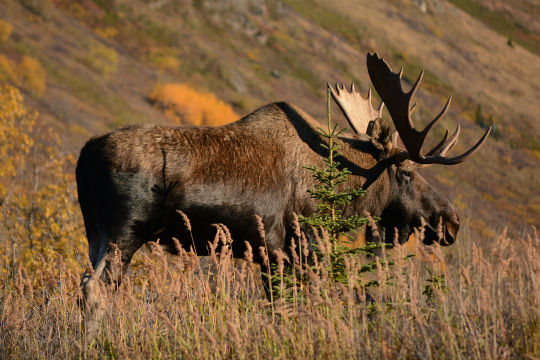
Bull moose in Alaska. Photo by Paxson Woelber, 2014.
Name in English: In Europe, elk. In North America, moose. Ambiguity warning: in North America, elk usually means wapiti (Cervus canadensis).
Name in French: Exactly the same problem. In Europe, élan. In North America, orignal (you are contractually obligated to make an orignal/original pun). Ambiguity warning: in North America, élan usually means wapiti (Cervus canadensis).
Lives in: All around the north pole: Canada and small parts of the northern US, northern Europe, Siberia.
Shoulder height: 1.5–2 m, by far the biggest deer.
Moose are good swimmers and browse for aquatic plants. Their oddly-shaped nose gives them an excellent sense of smell, and their long legs allow them to walk through snow easily. They're mostly solitary outside mating season. They usually have one calf, but twins are very common when food is plentiful.
Siberian musk deer (Moschus moschiferus) (not a deer)
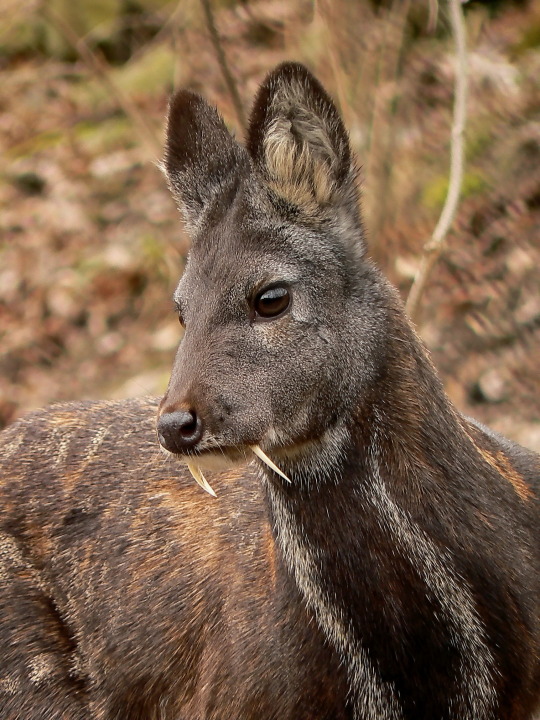
Male Siberian musk deer at a zoo in Plzeň, Czechia. Photo by Николай Усик (Nicolai Usik), 2011.
Name in English: No really common name, just Siberian musk deer.
Name in French: No really common name, just porte-musc de Sibérie.
Lives in: Far east Asia: Korea, eastern Siberia, Mongolia, northeastern China.
Shoulder height: About 50 cm.
Musk deer are not true deer; they're more closely related to cows. There are seven species, living mostly in South Asia. None have antlers or horns, and males of all species have tusks.
Siberian musk deer are solitary and territorial. They live in sloped taiga, are nocturnal, and mainly eat lichen. Females are larger than males, for once. Litter size varies, with one, two, or three young.
Males have a gland in their schlong that makes musk, a scented substance used in perfumes and traditional medicine. They are poached for their musk and musk glands, making the species vulnerable.
Family tree of all the guys above
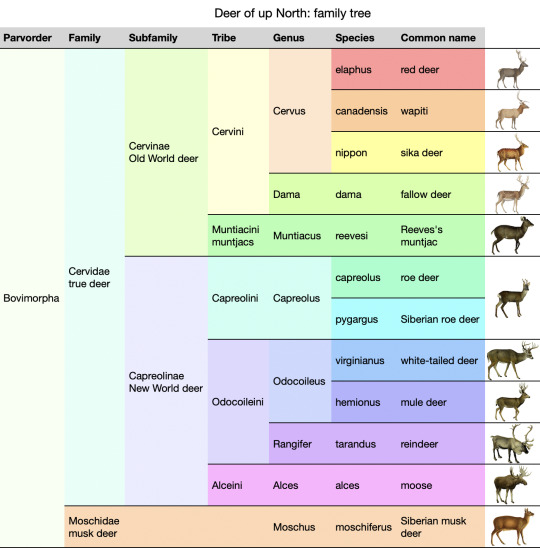
Family tree of these 12 deer. Note that the "Old World" and "New World" names for the two subfamilies are kinda fake and gay: wapiti live in the New World; roe deer live in the Old World but are the poster child of the New World family; reindeer and moose live in both.
Other cool deer include the many deer of the Indian subcontinent, like the sambar (Rusa unicolor), and the small deer of South America, like the pudu (Pudu sp). Other cool non-deer include the tiny adorable mouse-deer (chevrotains, Tragulidae).
#taxonomy#effortpost#deer#Cervidae#Ruminantia#Artiodactyla#ungulate#mammal#Mammalia#this is largely a note to self#long post cw#very long post cw
0 notes
Text
Hunting trips

The show begins at the first sign of light when turkeys fly down from their roost, and simultaneously upon landing, the orchestra begins. Turkeys are abundant on the ranch and their Valentines day arrives in April. These magnificent birds are plentiful on our land and these hunts are beyond enjoyable. In the spring, Bar 5 Ranch will guide you through a prestigious hunt of wild turkeys. Join us to hunt some of the finest Mule Deer in this part of the world. Their magnificent antlers are stunning against the backdrop of the breathtaking landscape of Bar 5 Ranch, and their presence is commanding in the wild. Our deer hunts are conducted slowly and methodically, constantly glassing and covering as much acreage as possible to find our clients a mature Mule Deer buck. Thousands of elk were killed mainly for those canines until this practice was outlawed.Įlk meat is palatable, dark and similar to beef in taste, hundreds of tons reach the dinner tables of sportsmen every year. Elk have thirty-four teeth, twelve molars, twelve pre-molars, eight incisors and two ivory-like canines which were highly prized by the Indians and used in making jewelry. The most polygamous of the deer family is the elk, it is not unusual to see a bull with twenty to thirty cows. During the rut a bull elk is in his prime antlers polished sharp and fully grown, neck swollen from being engorged with blood and remain swollen for about two months. Wapiti is another name for the elk, a Shawnee Indian name which never gained popularity.Įlk made a remarkable comeback from near total extinction, and Yellowstone Park enacted by congress saved the elk, reduced to a mere 400 in 1881, Yellowstone became the breeding grounds and as recovery began so did the shipping to other states to repopulate.Ī trophy elk hunt at Bar 5 Ranch is a memorable experience, to say the least, during the September and October ruts bulls bugling echoes throughout the forest and ridge tops, a message of challenge and assertion as they seek out the cows, the rest of the year they don’t utter a sound. The most sought after trophy in North America is the elk, a majestic and resilient animal. Our guides will ensure that your experience is an unforgettable one throughout your hunting career. Our fair-chance hunting season runs from early September through October. The elk hunting experience at Bar 5 Ranch is one of the most exclusive in the country. Due to the location, abundant rich food sources and over 20 ponds and lakes, wildlife tends to migrate to the Bar 5 Ranch.All hunting trips are led by experienced guides one guide per two hunters. (host to 10,000 acres)of wildlife paradise offers excellent habitat for elk, deer, bear, lion, turkey, bobcat and trout. We invite you to experience the best of the outdoors.

0 notes
Text
Firewatch cervid accuracy 10/10 btw
#Delilah suggests that a bull elk couldve destroyed the tent but given the time i probably wouldnt think so but i appreciate the suggestion#Wapiti station<3 theyre tracking elk<3 the elk bugle at that one bit <3#buggyposting
3 notes
·
View notes
Photo

Contented bull by Photosuze Elk This male seemed very content to sit in this field, closing his eyes and occasionally chewing. His harem was nearby. https://flic.kr/p/2iuDs7J
10 notes
·
View notes
Video
His Royal Majesty by Shannon O'Shea Wildlife Photography
Via Flickr:
Wild 12pt. Bull Elk, Yellowstone National Park, Wyoming. A 12pt. (6X6) Elk is called a "Royal" Bull.
#Shannon Rose O'Shea#Shannon O'Shea Wildlife Photography#Shannon O'Shea#Shannon#Elk#Wild Elk#Bull Elk#Wild Bull Elk#Wapiti#Male#Bull#Cervus canadensis#Herbivore#Deer family#Antlers#Stag#Rack#Yellowstone National Park#Wyoming#Grass#Animal#Mammal#Outdoors#Outdoor#Outside#Colorful#Colourful#Colors#Colours#Flickr
2 notes
·
View notes
Text

A bull wapiti (Cervus canadensis) in Yellowstone National Park, USA
by Stormpeak_1
#wapiti#elk#deer#cervus canadensis#cervus#cervidae#artiodactyla#mammalia#chordata#wildlife: usa#wildlife: north america
74 notes
·
View notes
Photo

Meadows edge
9-21
57 notes
·
View notes
Video
Sometimes, it doesn’t matter how late it is... you just gotta let arrows fly. First time in almost a year I’ve shot 3 fingers instead of my thumb. ⠀⠀⠀⠀⠀⠀⠀⠀⠀ Even I miss shooting a right handed bow right handed... sometimes. 😅 still it’s another opportunity for concentration practice. ⠀⠀⠀⠀⠀⠀⠀⠀⠀ Have an awesome weekend ya’ll! ⠀⠀⠀⠀⠀⠀⠀⠀⠀ . . . “The world offers you comfort. But you were not made for comfort. You were made for greatness.” - Pope Emeritus Benedict XVI - . . . ⠀⠀⠀⠀⠀⠀⠀⠀⠀ #entrepreneur #bowhunting #wapiti #riflehunting #whitetail #shotiq #patience #eatwild #3006 #virtue #bugle #getprimal #isitseptemberyet #fletching #muledeer #blacktail #catholic #rmef #bull #moose #elk #buck #stickbow #wapiti #bowseason #bullelk #hunting #recurve #tradbow #tradlife https://www.instagram.com/p/BskQmnwBL5H/?utm_source=ig_tumblr_share&igshid=10nbf3gbcdfqb
#entrepreneur#bowhunting#wapiti#riflehunting#whitetail#shotiq#patience#eatwild#3006#virtue#bugle#getprimal#isitseptemberyet#fletching#muledeer#blacktail#catholic#rmef#bull#moose#elk#buck#stickbow#bowseason#bullelk#hunting#recurve#tradbow#tradlife
1 note
·
View note
Photo

Springtime Elk
A young cow elk I found in Selway Meadows last Spring.
Nikon D7100, Manual Mode, Tamron 150-600mm VC, F/6.3, ISO-1000, ET 1/500, Focal Length 600mm, Hand Held Vibration Control on
#Elk#Wapiti#cow#calf#bull#deer#Wildlife#wildlife photography#wildlife photographer#wildlife art#wildlife photo#wildlife photograph#wildlife photo art#nature#natural light#explore#image#rocky#mountains#Rocky Mountains#Rockies#Beaverhead#Beaverhead-Deerlodge National Forest#photo#photography#photograph#photographer#photography art#photo art#Photos of Southwest Montana
22 notes
·
View notes
